Financial Management Report: Ethical Considerations in Finance
VerifiedAdded on 2023/01/10
|18
|5073
|53
Report
AI Summary
This report delves into the realm of financial management, exploring a range of approaches, techniques, and factors that contribute to effective decision-making within the context of Tesco Plc. It examines stakeholder management, including potential conflicts between management and shareholders, and highlights the value of management accounting in supporting financial decisions. The report also addresses the critical issues of fraud and its detection, emphasizing ethical considerations in the decision-making process. Furthermore, the report covers investment appraisal techniques, financial analysis, risk management and explores how financial decision-making supports long-term sustainability and provides recommendations for improving financial stability. The analysis covers both Scenario A which covers financial management, and Scenario B which focuses on investment appraisal techniques.

Financial
Management
Management
Paraphrase This Document
Need a fresh take? Get an instant paraphrase of this document with our AI Paraphraser
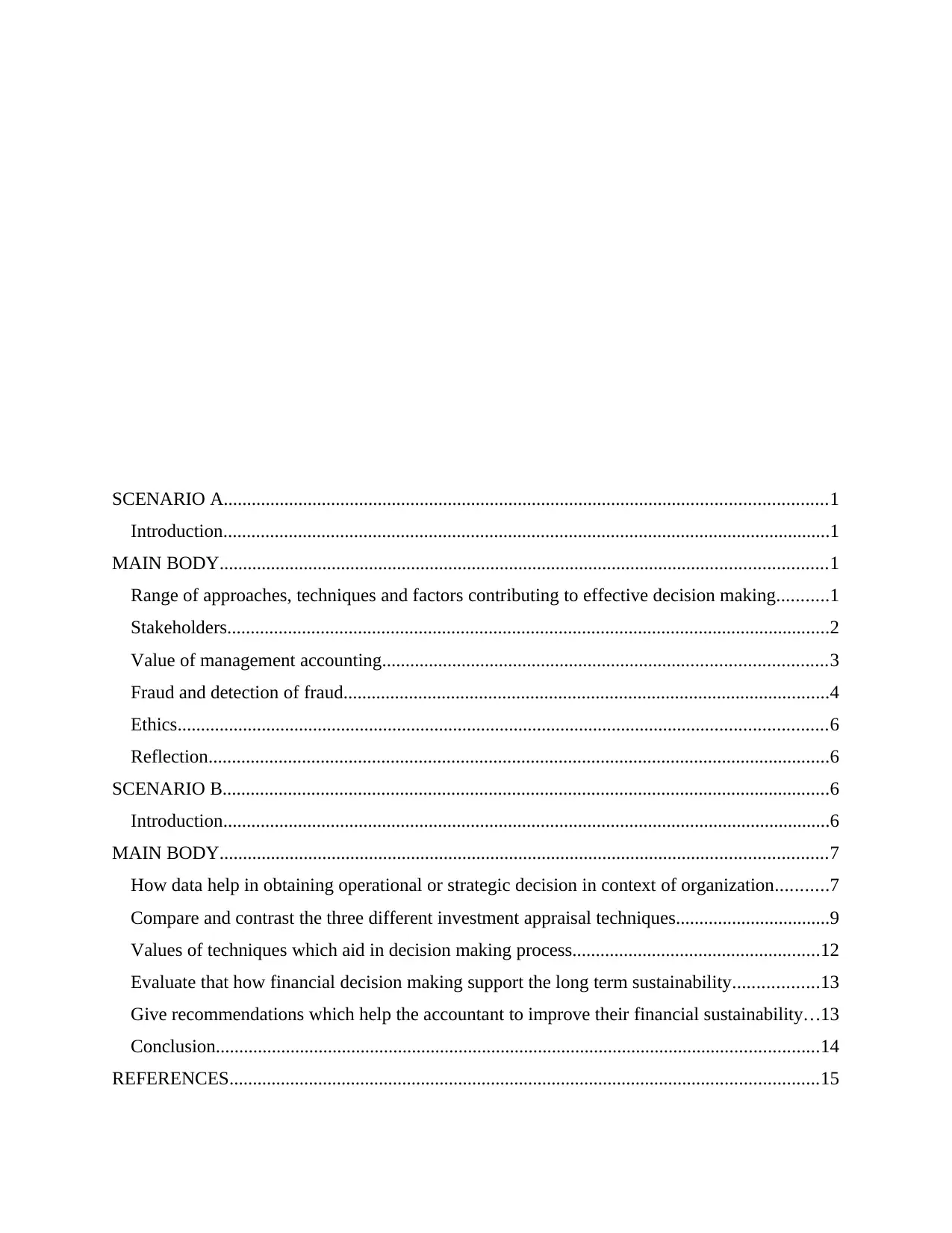
SCENARIO A.................................................................................................................................1
Introduction..................................................................................................................................1
MAIN BODY..................................................................................................................................1
Range of approaches, techniques and factors contributing to effective decision making...........1
Stakeholders.................................................................................................................................2
Value of management accounting...............................................................................................3
Fraud and detection of fraud........................................................................................................4
Ethics...........................................................................................................................................6
Reflection.....................................................................................................................................6
SCENARIO B..................................................................................................................................6
Introduction..................................................................................................................................6
MAIN BODY..................................................................................................................................7
How data help in obtaining operational or strategic decision in context of organization...........7
Compare and contrast the three different investment appraisal techniques.................................9
Values of techniques which aid in decision making process.....................................................12
Evaluate that how financial decision making support the long term sustainability..................13
Give recommendations which help the accountant to improve their financial sustainability...13
Conclusion.................................................................................................................................14
REFERENCES..............................................................................................................................15
Introduction..................................................................................................................................1
MAIN BODY..................................................................................................................................1
Range of approaches, techniques and factors contributing to effective decision making...........1
Stakeholders.................................................................................................................................2
Value of management accounting...............................................................................................3
Fraud and detection of fraud........................................................................................................4
Ethics...........................................................................................................................................6
Reflection.....................................................................................................................................6
SCENARIO B..................................................................................................................................6
Introduction..................................................................................................................................6
MAIN BODY..................................................................................................................................7
How data help in obtaining operational or strategic decision in context of organization...........7
Compare and contrast the three different investment appraisal techniques.................................9
Values of techniques which aid in decision making process.....................................................12
Evaluate that how financial decision making support the long term sustainability..................13
Give recommendations which help the accountant to improve their financial sustainability...13
Conclusion.................................................................................................................................14
REFERENCES..............................................................................................................................15

⊘ This is a preview!⊘
Do you want full access?
Subscribe today to unlock all pages.

Trusted by 1+ million students worldwide
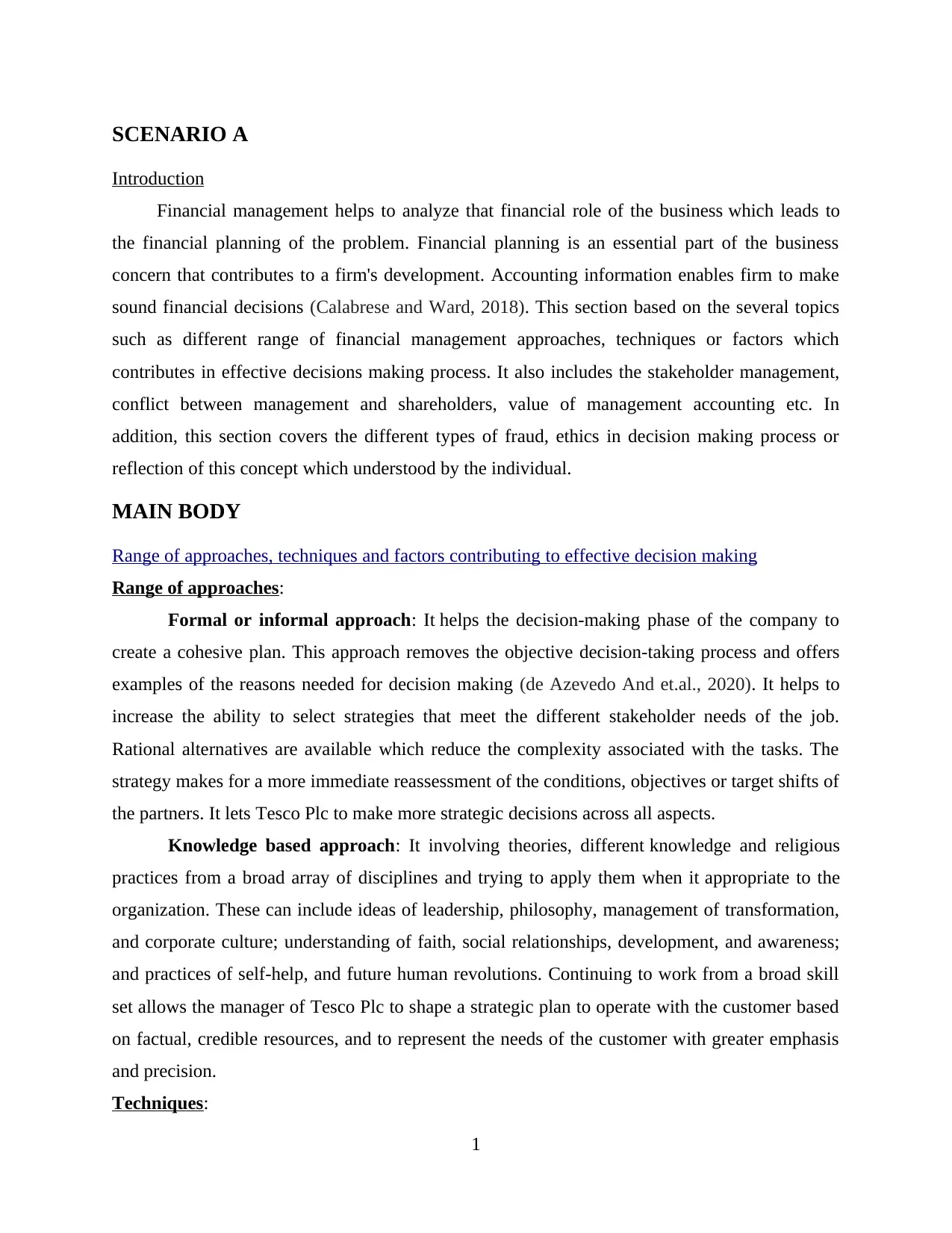
SCENARIO A
Introduction
Financial management helps to analyze that financial role of the business which leads to
the financial planning of the problem. Financial planning is an essential part of the business
concern that contributes to a firm's development. Accounting information enables firm to make
sound financial decisions (Calabrese and Ward, 2018). This section based on the several topics
such as different range of financial management approaches, techniques or factors which
contributes in effective decisions making process. It also includes the stakeholder management,
conflict between management and shareholders, value of management accounting etc. In
addition, this section covers the different types of fraud, ethics in decision making process or
reflection of this concept which understood by the individual.
MAIN BODY
Range of approaches, techniques and factors contributing to effective decision making
Range of approaches:
Formal or informal approach: It helps the decision-making phase of the company to
create a cohesive plan. This approach removes the objective decision-taking process and offers
examples of the reasons needed for decision making (de Azevedo And et.al., 2020). It helps to
increase the ability to select strategies that meet the different stakeholder needs of the job.
Rational alternatives are available which reduce the complexity associated with the tasks. The
strategy makes for a more immediate reassessment of the conditions, objectives or target shifts of
the partners. It lets Tesco Plc to make more strategic decisions across all aspects.
Knowledge based approach: It involving theories, different knowledge and religious
practices from a broad array of disciplines and trying to apply them when it appropriate to the
organization. These can include ideas of leadership, philosophy, management of transformation,
and corporate culture; understanding of faith, social relationships, development, and awareness;
and practices of self-help, and future human revolutions. Continuing to work from a broad skill
set allows the manager of Tesco Plc to shape a strategic plan to operate with the customer based
on factual, credible resources, and to represent the needs of the customer with greater emphasis
and precision.
Techniques:
1
Introduction
Financial management helps to analyze that financial role of the business which leads to
the financial planning of the problem. Financial planning is an essential part of the business
concern that contributes to a firm's development. Accounting information enables firm to make
sound financial decisions (Calabrese and Ward, 2018). This section based on the several topics
such as different range of financial management approaches, techniques or factors which
contributes in effective decisions making process. It also includes the stakeholder management,
conflict between management and shareholders, value of management accounting etc. In
addition, this section covers the different types of fraud, ethics in decision making process or
reflection of this concept which understood by the individual.
MAIN BODY
Range of approaches, techniques and factors contributing to effective decision making
Range of approaches:
Formal or informal approach: It helps the decision-making phase of the company to
create a cohesive plan. This approach removes the objective decision-taking process and offers
examples of the reasons needed for decision making (de Azevedo And et.al., 2020). It helps to
increase the ability to select strategies that meet the different stakeholder needs of the job.
Rational alternatives are available which reduce the complexity associated with the tasks. The
strategy makes for a more immediate reassessment of the conditions, objectives or target shifts of
the partners. It lets Tesco Plc to make more strategic decisions across all aspects.
Knowledge based approach: It involving theories, different knowledge and religious
practices from a broad array of disciplines and trying to apply them when it appropriate to the
organization. These can include ideas of leadership, philosophy, management of transformation,
and corporate culture; understanding of faith, social relationships, development, and awareness;
and practices of self-help, and future human revolutions. Continuing to work from a broad skill
set allows the manager of Tesco Plc to shape a strategic plan to operate with the customer based
on factual, credible resources, and to represent the needs of the customer with greater emphasis
and precision.
Techniques:
1
Paraphrase This Document
Need a fresh take? Get an instant paraphrase of this document with our AI Paraphraser
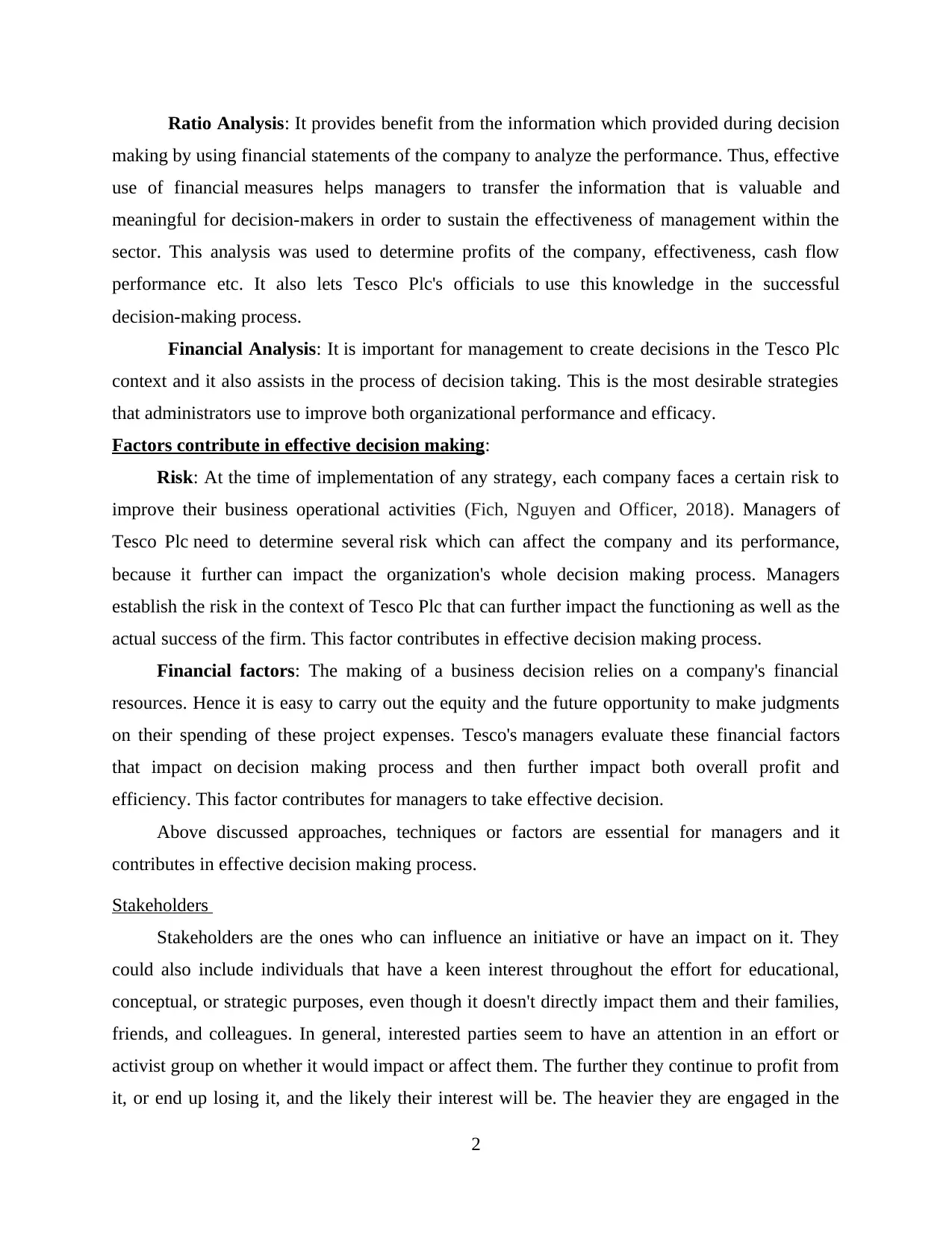
Ratio Analysis: It provides benefit from the information which provided during decision
making by using financial statements of the company to analyze the performance. Thus, effective
use of financial measures helps managers to transfer the information that is valuable and
meaningful for decision-makers in order to sustain the effectiveness of management within the
sector. This analysis was used to determine profits of the company, effectiveness, cash flow
performance etc. It also lets Tesco Plc's officials to use this knowledge in the successful
decision-making process.
Financial Analysis: It is important for management to create decisions in the Tesco Plc
context and it also assists in the process of decision taking. This is the most desirable strategies
that administrators use to improve both organizational performance and efficacy.
Factors contribute in effective decision making:
Risk: At the time of implementation of any strategy, each company faces a certain risk to
improve their business operational activities (Fich, Nguyen and Officer, 2018). Managers of
Tesco Plc need to determine several risk which can affect the company and its performance,
because it further can impact the organization's whole decision making process. Managers
establish the risk in the context of Tesco Plc that can further impact the functioning as well as the
actual success of the firm. This factor contributes in effective decision making process.
Financial factors: The making of a business decision relies on a company's financial
resources. Hence it is easy to carry out the equity and the future opportunity to make judgments
on their spending of these project expenses. Tesco's managers evaluate these financial factors
that impact on decision making process and then further impact both overall profit and
efficiency. This factor contributes for managers to take effective decision.
Above discussed approaches, techniques or factors are essential for managers and it
contributes in effective decision making process.
Stakeholders
Stakeholders are the ones who can influence an initiative or have an impact on it. They
could also include individuals that have a keen interest throughout the effort for educational,
conceptual, or strategic purposes, even though it doesn't directly impact them and their families,
friends, and colleagues. In general, interested parties seem to have an attention in an effort or
activist group on whether it would impact or affect them. The further they continue to profit from
it, or end up losing it, and the likely their interest will be. The heavier they are engaged in the
2
making by using financial statements of the company to analyze the performance. Thus, effective
use of financial measures helps managers to transfer the information that is valuable and
meaningful for decision-makers in order to sustain the effectiveness of management within the
sector. This analysis was used to determine profits of the company, effectiveness, cash flow
performance etc. It also lets Tesco Plc's officials to use this knowledge in the successful
decision-making process.
Financial Analysis: It is important for management to create decisions in the Tesco Plc
context and it also assists in the process of decision taking. This is the most desirable strategies
that administrators use to improve both organizational performance and efficacy.
Factors contribute in effective decision making:
Risk: At the time of implementation of any strategy, each company faces a certain risk to
improve their business operational activities (Fich, Nguyen and Officer, 2018). Managers of
Tesco Plc need to determine several risk which can affect the company and its performance,
because it further can impact the organization's whole decision making process. Managers
establish the risk in the context of Tesco Plc that can further impact the functioning as well as the
actual success of the firm. This factor contributes in effective decision making process.
Financial factors: The making of a business decision relies on a company's financial
resources. Hence it is easy to carry out the equity and the future opportunity to make judgments
on their spending of these project expenses. Tesco's managers evaluate these financial factors
that impact on decision making process and then further impact both overall profit and
efficiency. This factor contributes for managers to take effective decision.
Above discussed approaches, techniques or factors are essential for managers and it
contributes in effective decision making process.
Stakeholders
Stakeholders are the ones who can influence an initiative or have an impact on it. They
could also include individuals that have a keen interest throughout the effort for educational,
conceptual, or strategic purposes, even though it doesn't directly impact them and their families,
friends, and colleagues. In general, interested parties seem to have an attention in an effort or
activist group on whether it would impact or affect them. The further they continue to profit from
it, or end up losing it, and the likely their interest will be. The heavier they are engaged in the
2
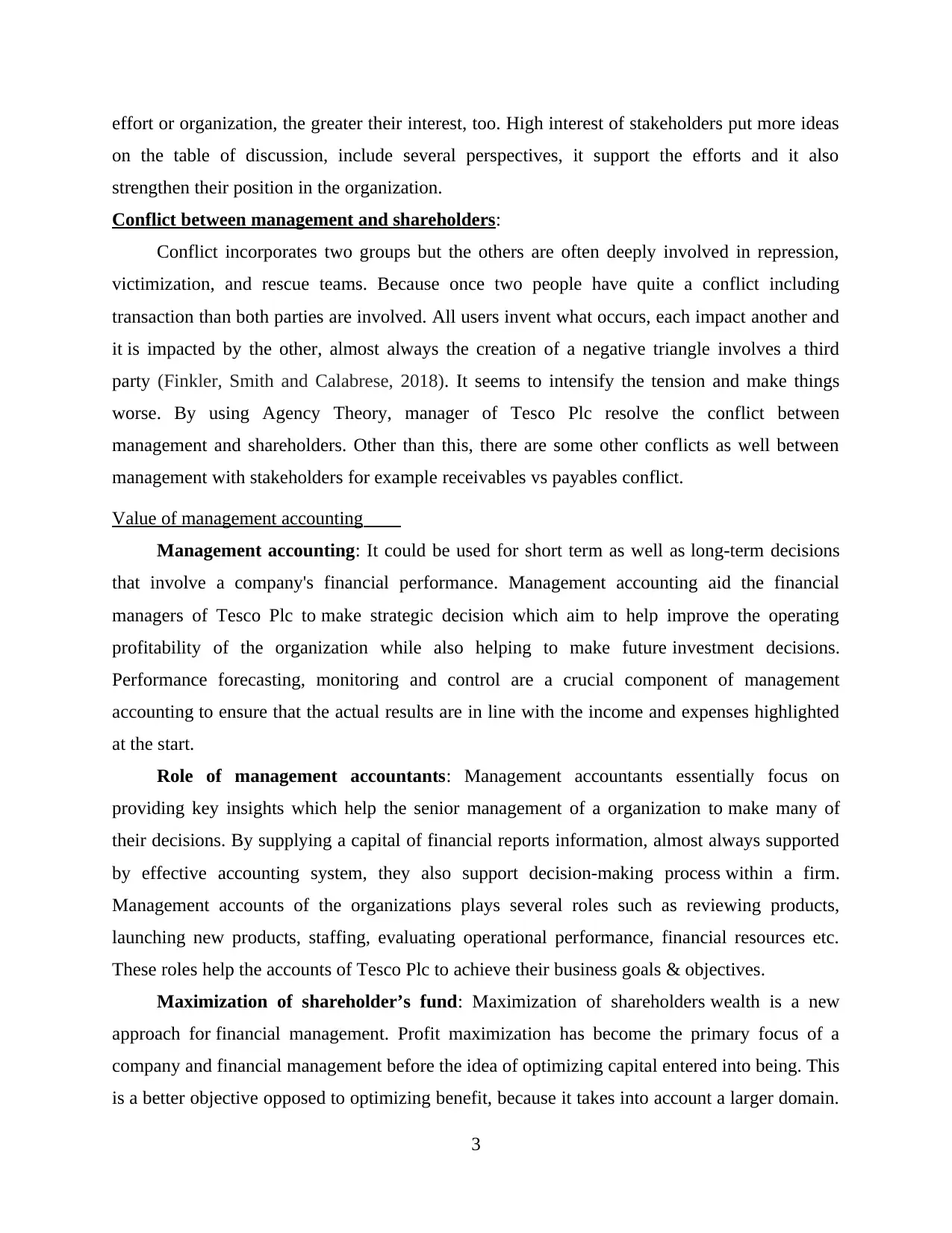
effort or organization, the greater their interest, too. High interest of stakeholders put more ideas
on the table of discussion, include several perspectives, it support the efforts and it also
strengthen their position in the organization.
Conflict between management and shareholders:
Conflict incorporates two groups but the others are often deeply involved in repression,
victimization, and rescue teams. Because once two people have quite a conflict including
transaction than both parties are involved. All users invent what occurs, each impact another and
it is impacted by the other, almost always the creation of a negative triangle involves a third
party (Finkler, Smith and Calabrese, 2018). It seems to intensify the tension and make things
worse. By using Agency Theory, manager of Tesco Plc resolve the conflict between
management and shareholders. Other than this, there are some other conflicts as well between
management with stakeholders for example receivables vs payables conflict.
Value of management accounting
Management accounting: It could be used for short term as well as long-term decisions
that involve a company's financial performance. Management accounting aid the financial
managers of Tesco Plc to make strategic decision which aim to help improve the operating
profitability of the organization while also helping to make future investment decisions.
Performance forecasting, monitoring and control are a crucial component of management
accounting to ensure that the actual results are in line with the income and expenses highlighted
at the start.
Role of management accountants: Management accountants essentially focus on
providing key insights which help the senior management of a organization to make many of
their decisions. By supplying a capital of financial reports information, almost always supported
by effective accounting system, they also support decision-making process within a firm.
Management accounts of the organizations plays several roles such as reviewing products,
launching new products, staffing, evaluating operational performance, financial resources etc.
These roles help the accounts of Tesco Plc to achieve their business goals & objectives.
Maximization of shareholder’s fund: Maximization of shareholders wealth is a new
approach for financial management. Profit maximization has become the primary focus of a
company and financial management before the idea of optimizing capital entered into being. This
is a better objective opposed to optimizing benefit, because it takes into account a larger domain.
3
on the table of discussion, include several perspectives, it support the efforts and it also
strengthen their position in the organization.
Conflict between management and shareholders:
Conflict incorporates two groups but the others are often deeply involved in repression,
victimization, and rescue teams. Because once two people have quite a conflict including
transaction than both parties are involved. All users invent what occurs, each impact another and
it is impacted by the other, almost always the creation of a negative triangle involves a third
party (Finkler, Smith and Calabrese, 2018). It seems to intensify the tension and make things
worse. By using Agency Theory, manager of Tesco Plc resolve the conflict between
management and shareholders. Other than this, there are some other conflicts as well between
management with stakeholders for example receivables vs payables conflict.
Value of management accounting
Management accounting: It could be used for short term as well as long-term decisions
that involve a company's financial performance. Management accounting aid the financial
managers of Tesco Plc to make strategic decision which aim to help improve the operating
profitability of the organization while also helping to make future investment decisions.
Performance forecasting, monitoring and control are a crucial component of management
accounting to ensure that the actual results are in line with the income and expenses highlighted
at the start.
Role of management accountants: Management accountants essentially focus on
providing key insights which help the senior management of a organization to make many of
their decisions. By supplying a capital of financial reports information, almost always supported
by effective accounting system, they also support decision-making process within a firm.
Management accounts of the organizations plays several roles such as reviewing products,
launching new products, staffing, evaluating operational performance, financial resources etc.
These roles help the accounts of Tesco Plc to achieve their business goals & objectives.
Maximization of shareholder’s fund: Maximization of shareholders wealth is a new
approach for financial management. Profit maximization has become the primary focus of a
company and financial management before the idea of optimizing capital entered into being. This
is a better objective opposed to optimizing benefit, because it takes into account a larger domain.
3
⊘ This is a preview!⊘
Do you want full access?
Subscribe today to unlock all pages.

Trusted by 1+ million students worldwide
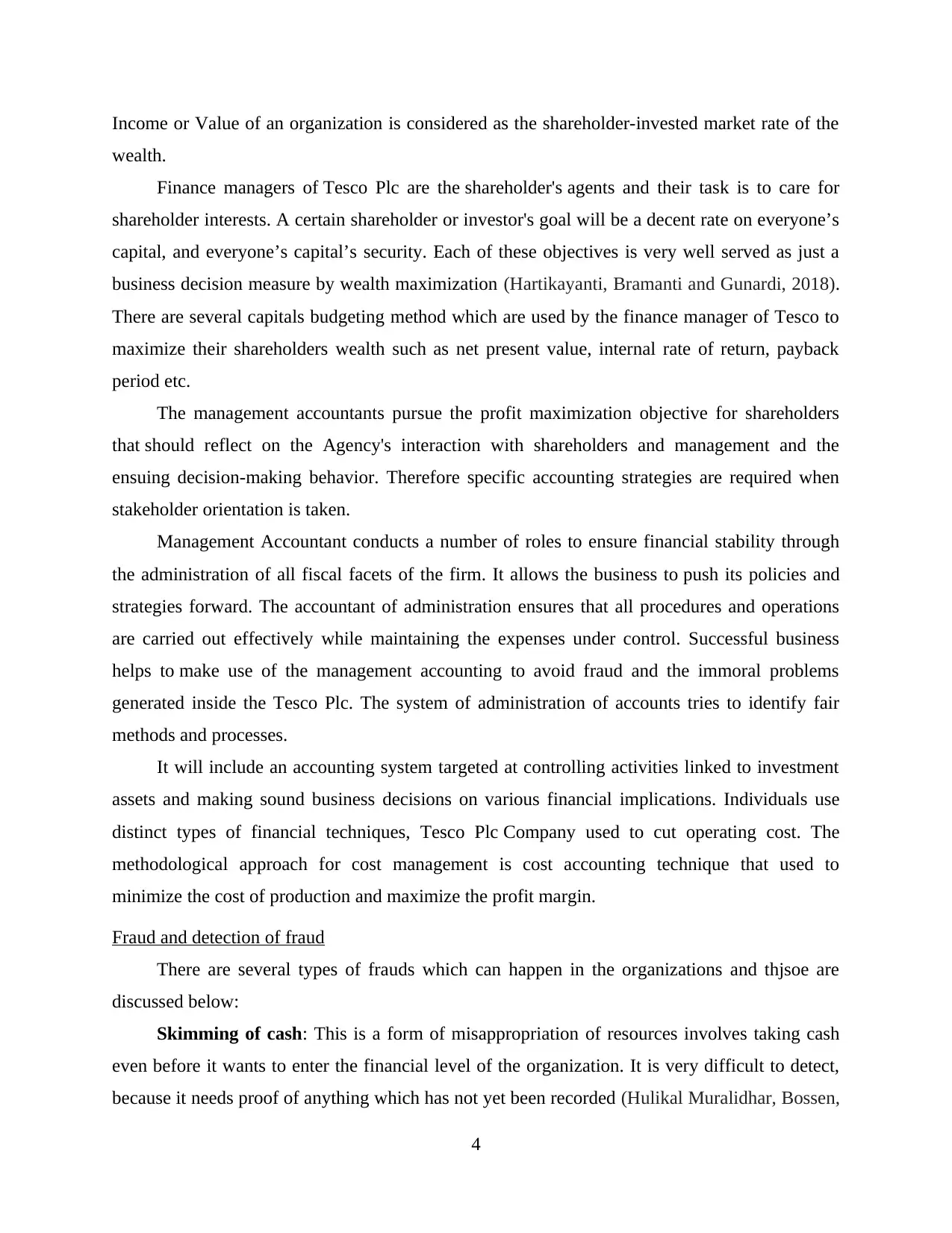
Income or Value of an organization is considered as the shareholder-invested market rate of the
wealth.
Finance managers of Tesco Plc are the shareholder's agents and their task is to care for
shareholder interests. A certain shareholder or investor's goal will be a decent rate on everyone’s
capital, and everyone’s capital’s security. Each of these objectives is very well served as just a
business decision measure by wealth maximization (Hartikayanti, Bramanti and Gunardi, 2018).
There are several capitals budgeting method which are used by the finance manager of Tesco to
maximize their shareholders wealth such as net present value, internal rate of return, payback
period etc.
The management accountants pursue the profit maximization objective for shareholders
that should reflect on the Agency's interaction with shareholders and management and the
ensuing decision-making behavior. Therefore specific accounting strategies are required when
stakeholder orientation is taken.
Management Accountant conducts a number of roles to ensure financial stability through
the administration of all fiscal facets of the firm. It allows the business to push its policies and
strategies forward. The accountant of administration ensures that all procedures and operations
are carried out effectively while maintaining the expenses under control. Successful business
helps to make use of the management accounting to avoid fraud and the immoral problems
generated inside the Tesco Plc. The system of administration of accounts tries to identify fair
methods and processes.
It will include an accounting system targeted at controlling activities linked to investment
assets and making sound business decisions on various financial implications. Individuals use
distinct types of financial techniques, Tesco Plc Company used to cut operating cost. The
methodological approach for cost management is cost accounting technique that used to
minimize the cost of production and maximize the profit margin.
Fraud and detection of fraud
There are several types of frauds which can happen in the organizations and thjsoe are
discussed below:
Skimming of cash: This is a form of misappropriation of resources involves taking cash
even before it wants to enter the financial level of the organization. It is very difficult to detect,
because it needs proof of anything which has not yet been recorded (Hulikal Muralidhar, Bossen,
4
wealth.
Finance managers of Tesco Plc are the shareholder's agents and their task is to care for
shareholder interests. A certain shareholder or investor's goal will be a decent rate on everyone’s
capital, and everyone’s capital’s security. Each of these objectives is very well served as just a
business decision measure by wealth maximization (Hartikayanti, Bramanti and Gunardi, 2018).
There are several capitals budgeting method which are used by the finance manager of Tesco to
maximize their shareholders wealth such as net present value, internal rate of return, payback
period etc.
The management accountants pursue the profit maximization objective for shareholders
that should reflect on the Agency's interaction with shareholders and management and the
ensuing decision-making behavior. Therefore specific accounting strategies are required when
stakeholder orientation is taken.
Management Accountant conducts a number of roles to ensure financial stability through
the administration of all fiscal facets of the firm. It allows the business to push its policies and
strategies forward. The accountant of administration ensures that all procedures and operations
are carried out effectively while maintaining the expenses under control. Successful business
helps to make use of the management accounting to avoid fraud and the immoral problems
generated inside the Tesco Plc. The system of administration of accounts tries to identify fair
methods and processes.
It will include an accounting system targeted at controlling activities linked to investment
assets and making sound business decisions on various financial implications. Individuals use
distinct types of financial techniques, Tesco Plc Company used to cut operating cost. The
methodological approach for cost management is cost accounting technique that used to
minimize the cost of production and maximize the profit margin.
Fraud and detection of fraud
There are several types of frauds which can happen in the organizations and thjsoe are
discussed below:
Skimming of cash: This is a form of misappropriation of resources involves taking cash
even before it wants to enter the financial level of the organization. It is very difficult to detect,
because it needs proof of anything which has not yet been recorded (Hulikal Muralidhar, Bossen,
4
Paraphrase This Document
Need a fresh take? Get an instant paraphrase of this document with our AI Paraphraser
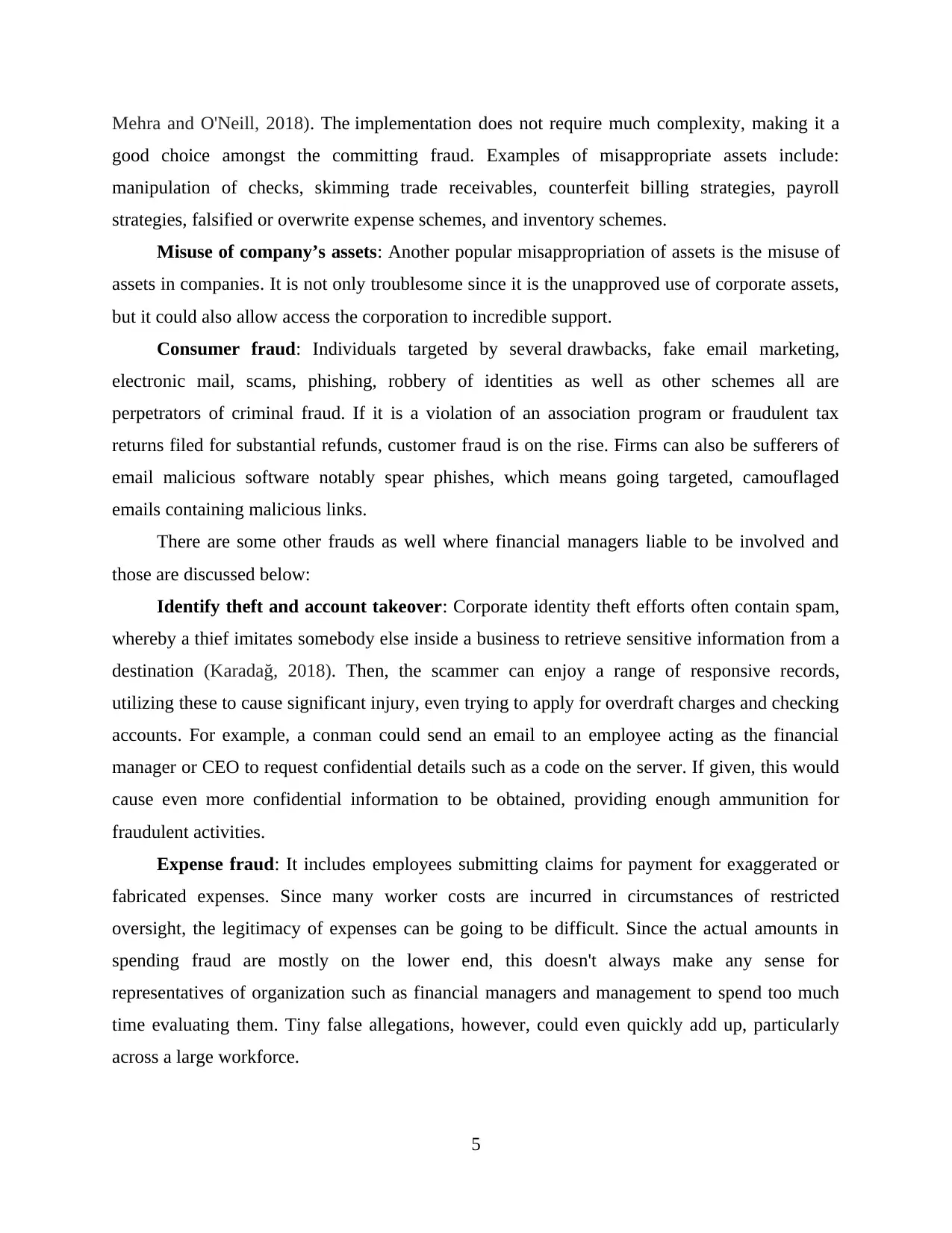
Mehra and O'Neill, 2018). The implementation does not require much complexity, making it a
good choice amongst the committing fraud. Examples of misappropriate assets include:
manipulation of checks, skimming trade receivables, counterfeit billing strategies, payroll
strategies, falsified or overwrite expense schemes, and inventory schemes.
Misuse of company’s assets: Another popular misappropriation of assets is the misuse of
assets in companies. It is not only troublesome since it is the unapproved use of corporate assets,
but it could also allow access the corporation to incredible support.
Consumer fraud: Individuals targeted by several drawbacks, fake email marketing,
electronic mail, scams, phishing, robbery of identities as well as other schemes all are
perpetrators of criminal fraud. If it is a violation of an association program or fraudulent tax
returns filed for substantial refunds, customer fraud is on the rise. Firms can also be sufferers of
email malicious software notably spear phishes, which means going targeted, camouflaged
emails containing malicious links.
There are some other frauds as well where financial managers liable to be involved and
those are discussed below:
Identify theft and account takeover: Corporate identity theft efforts often contain spam,
whereby a thief imitates somebody else inside a business to retrieve sensitive information from a
destination (Karadağ, 2018). Then, the scammer can enjoy a range of responsive records,
utilizing these to cause significant injury, even trying to apply for overdraft charges and checking
accounts. For example, a conman could send an email to an employee acting as the financial
manager or CEO to request confidential details such as a code on the server. If given, this would
cause even more confidential information to be obtained, providing enough ammunition for
fraudulent activities.
Expense fraud: It includes employees submitting claims for payment for exaggerated or
fabricated expenses. Since many worker costs are incurred in circumstances of restricted
oversight, the legitimacy of expenses can be going to be difficult. Since the actual amounts in
spending fraud are mostly on the lower end, this doesn't always make any sense for
representatives of organization such as financial managers and management to spend too much
time evaluating them. Tiny false allegations, however, could even quickly add up, particularly
across a large workforce.
5
good choice amongst the committing fraud. Examples of misappropriate assets include:
manipulation of checks, skimming trade receivables, counterfeit billing strategies, payroll
strategies, falsified or overwrite expense schemes, and inventory schemes.
Misuse of company’s assets: Another popular misappropriation of assets is the misuse of
assets in companies. It is not only troublesome since it is the unapproved use of corporate assets,
but it could also allow access the corporation to incredible support.
Consumer fraud: Individuals targeted by several drawbacks, fake email marketing,
electronic mail, scams, phishing, robbery of identities as well as other schemes all are
perpetrators of criminal fraud. If it is a violation of an association program or fraudulent tax
returns filed for substantial refunds, customer fraud is on the rise. Firms can also be sufferers of
email malicious software notably spear phishes, which means going targeted, camouflaged
emails containing malicious links.
There are some other frauds as well where financial managers liable to be involved and
those are discussed below:
Identify theft and account takeover: Corporate identity theft efforts often contain spam,
whereby a thief imitates somebody else inside a business to retrieve sensitive information from a
destination (Karadağ, 2018). Then, the scammer can enjoy a range of responsive records,
utilizing these to cause significant injury, even trying to apply for overdraft charges and checking
accounts. For example, a conman could send an email to an employee acting as the financial
manager or CEO to request confidential details such as a code on the server. If given, this would
cause even more confidential information to be obtained, providing enough ammunition for
fraudulent activities.
Expense fraud: It includes employees submitting claims for payment for exaggerated or
fabricated expenses. Since many worker costs are incurred in circumstances of restricted
oversight, the legitimacy of expenses can be going to be difficult. Since the actual amounts in
spending fraud are mostly on the lower end, this doesn't always make any sense for
representatives of organization such as financial managers and management to spend too much
time evaluating them. Tiny false allegations, however, could even quickly add up, particularly
across a large workforce.
5
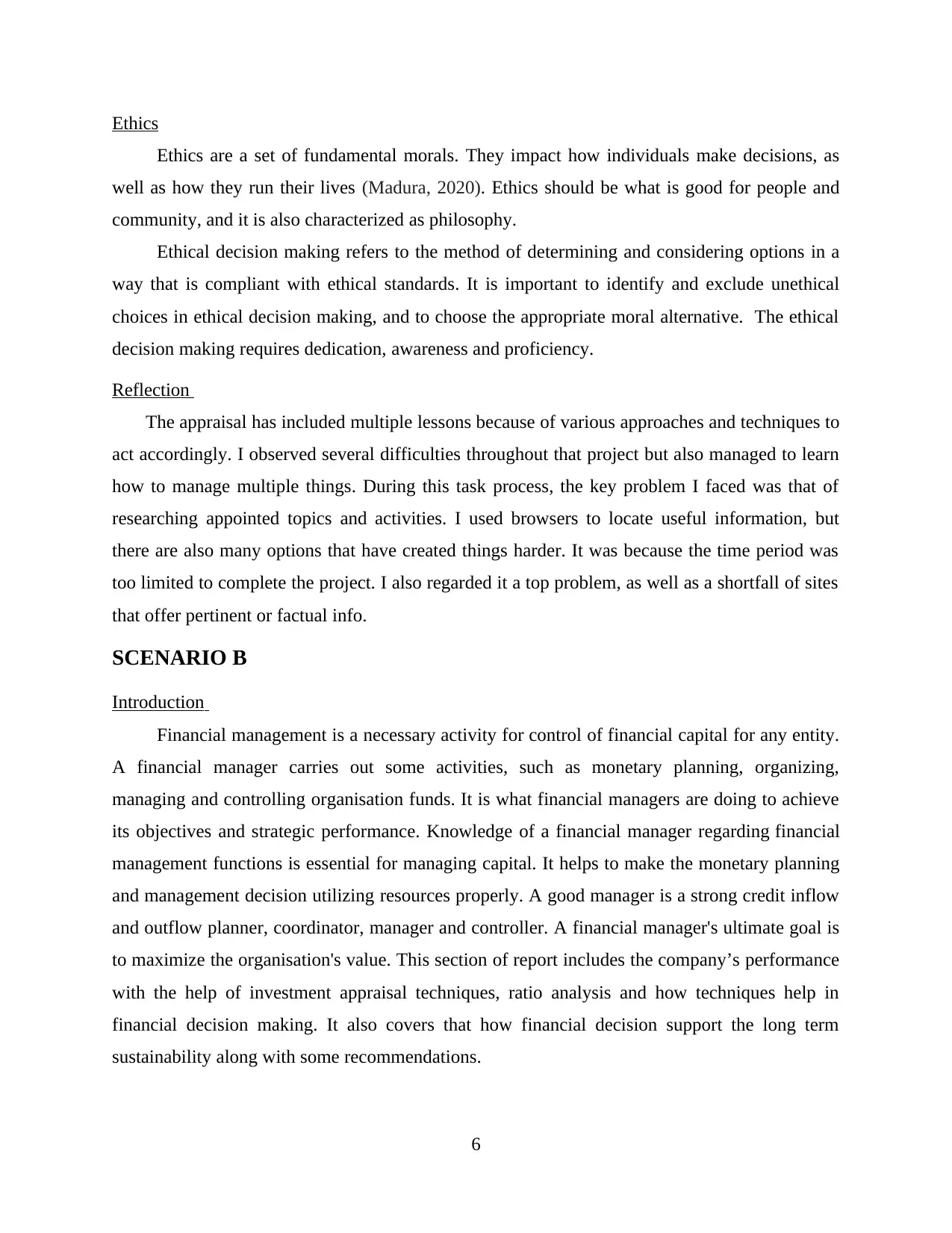
Ethics
Ethics are a set of fundamental morals. They impact how individuals make decisions, as
well as how they run their lives (Madura, 2020). Ethics should be what is good for people and
community, and it is also characterized as philosophy.
Ethical decision making refers to the method of determining and considering options in a
way that is compliant with ethical standards. It is important to identify and exclude unethical
choices in ethical decision making, and to choose the appropriate moral alternative. The ethical
decision making requires dedication, awareness and proficiency.
Reflection
The appraisal has included multiple lessons because of various approaches and techniques to
act accordingly. I observed several difficulties throughout that project but also managed to learn
how to manage multiple things. During this task process, the key problem I faced was that of
researching appointed topics and activities. I used browsers to locate useful information, but
there are also many options that have created things harder. It was because the time period was
too limited to complete the project. I also regarded it a top problem, as well as a shortfall of sites
that offer pertinent or factual info.
SCENARIO B
Introduction
Financial management is a necessary activity for control of financial capital for any entity.
A financial manager carries out some activities, such as monetary planning, organizing,
managing and controlling organisation funds. It is what financial managers are doing to achieve
its objectives and strategic performance. Knowledge of a financial manager regarding financial
management functions is essential for managing capital. It helps to make the monetary planning
and management decision utilizing resources properly. A good manager is a strong credit inflow
and outflow planner, coordinator, manager and controller. A financial manager's ultimate goal is
to maximize the organisation's value. This section of report includes the company’s performance
with the help of investment appraisal techniques, ratio analysis and how techniques help in
financial decision making. It also covers that how financial decision support the long term
sustainability along with some recommendations.
6
Ethics are a set of fundamental morals. They impact how individuals make decisions, as
well as how they run their lives (Madura, 2020). Ethics should be what is good for people and
community, and it is also characterized as philosophy.
Ethical decision making refers to the method of determining and considering options in a
way that is compliant with ethical standards. It is important to identify and exclude unethical
choices in ethical decision making, and to choose the appropriate moral alternative. The ethical
decision making requires dedication, awareness and proficiency.
Reflection
The appraisal has included multiple lessons because of various approaches and techniques to
act accordingly. I observed several difficulties throughout that project but also managed to learn
how to manage multiple things. During this task process, the key problem I faced was that of
researching appointed topics and activities. I used browsers to locate useful information, but
there are also many options that have created things harder. It was because the time period was
too limited to complete the project. I also regarded it a top problem, as well as a shortfall of sites
that offer pertinent or factual info.
SCENARIO B
Introduction
Financial management is a necessary activity for control of financial capital for any entity.
A financial manager carries out some activities, such as monetary planning, organizing,
managing and controlling organisation funds. It is what financial managers are doing to achieve
its objectives and strategic performance. Knowledge of a financial manager regarding financial
management functions is essential for managing capital. It helps to make the monetary planning
and management decision utilizing resources properly. A good manager is a strong credit inflow
and outflow planner, coordinator, manager and controller. A financial manager's ultimate goal is
to maximize the organisation's value. This section of report includes the company’s performance
with the help of investment appraisal techniques, ratio analysis and how techniques help in
financial decision making. It also covers that how financial decision support the long term
sustainability along with some recommendations.
6
⊘ This is a preview!⊘
Do you want full access?
Subscribe today to unlock all pages.

Trusted by 1+ million students worldwide
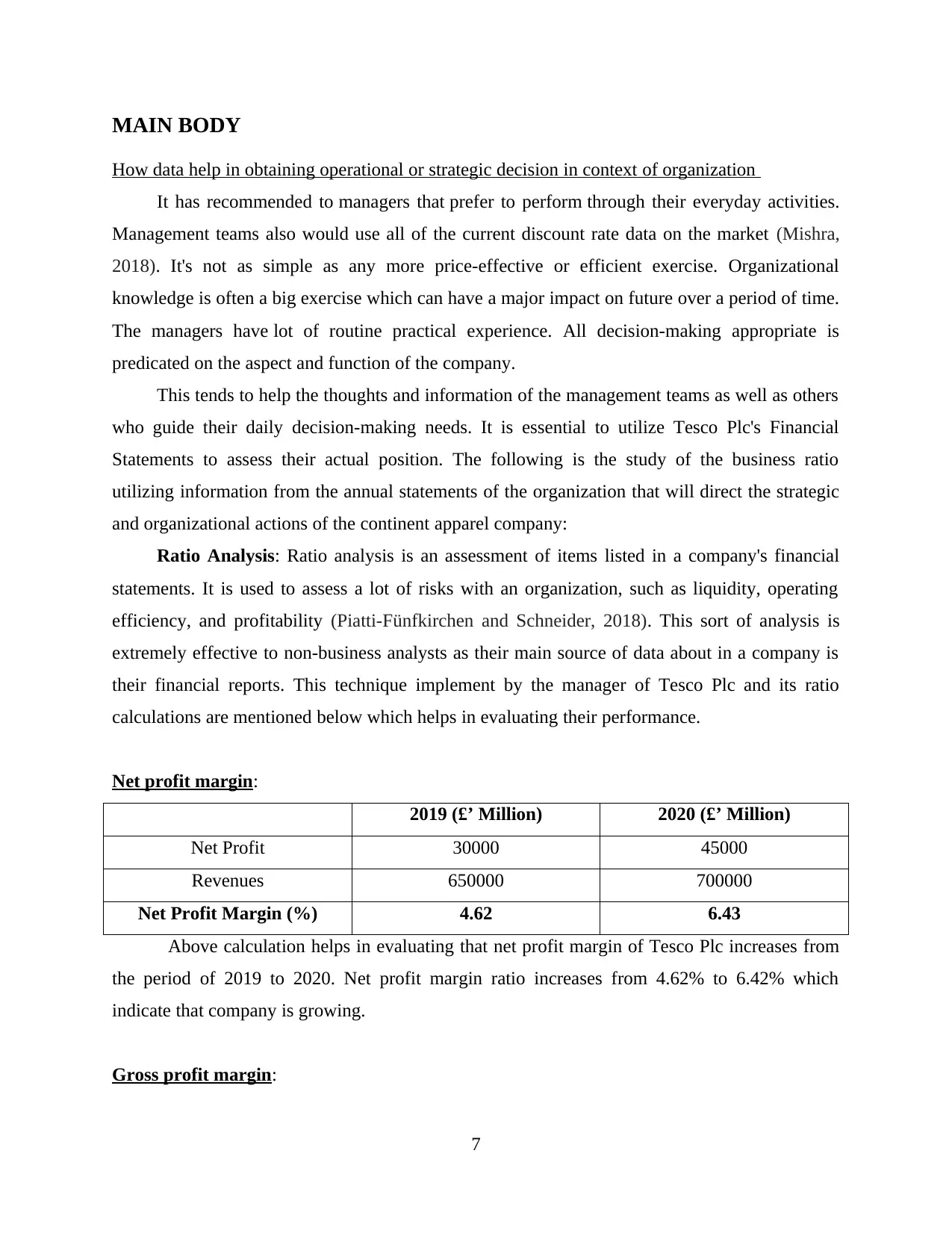
MAIN BODY
How data help in obtaining operational or strategic decision in context of organization
It has recommended to managers that prefer to perform through their everyday activities.
Management teams also would use all of the current discount rate data on the market (Mishra,
2018). It's not as simple as any more price-effective or efficient exercise. Organizational
knowledge is often a big exercise which can have a major impact on future over a period of time.
The managers have lot of routine practical experience. All decision-making appropriate is
predicated on the aspect and function of the company.
This tends to help the thoughts and information of the management teams as well as others
who guide their daily decision-making needs. It is essential to utilize Tesco Plc's Financial
Statements to assess their actual position. The following is the study of the business ratio
utilizing information from the annual statements of the organization that will direct the strategic
and organizational actions of the continent apparel company:
Ratio Analysis: Ratio analysis is an assessment of items listed in a company's financial
statements. It is used to assess a lot of risks with an organization, such as liquidity, operating
efficiency, and profitability (Piatti-Fünfkirchen and Schneider, 2018). This sort of analysis is
extremely effective to non-business analysts as their main source of data about in a company is
their financial reports. This technique implement by the manager of Tesco Plc and its ratio
calculations are mentioned below which helps in evaluating their performance.
Net profit margin:
2019 (£’ Million) 2020 (£’ Million)
Net Profit 30000 45000
Revenues 650000 700000
Net Profit Margin (%) 4.62 6.43
Above calculation helps in evaluating that net profit margin of Tesco Plc increases from
the period of 2019 to 2020. Net profit margin ratio increases from 4.62% to 6.42% which
indicate that company is growing.
Gross profit margin:
7
How data help in obtaining operational or strategic decision in context of organization
It has recommended to managers that prefer to perform through their everyday activities.
Management teams also would use all of the current discount rate data on the market (Mishra,
2018). It's not as simple as any more price-effective or efficient exercise. Organizational
knowledge is often a big exercise which can have a major impact on future over a period of time.
The managers have lot of routine practical experience. All decision-making appropriate is
predicated on the aspect and function of the company.
This tends to help the thoughts and information of the management teams as well as others
who guide their daily decision-making needs. It is essential to utilize Tesco Plc's Financial
Statements to assess their actual position. The following is the study of the business ratio
utilizing information from the annual statements of the organization that will direct the strategic
and organizational actions of the continent apparel company:
Ratio Analysis: Ratio analysis is an assessment of items listed in a company's financial
statements. It is used to assess a lot of risks with an organization, such as liquidity, operating
efficiency, and profitability (Piatti-Fünfkirchen and Schneider, 2018). This sort of analysis is
extremely effective to non-business analysts as their main source of data about in a company is
their financial reports. This technique implement by the manager of Tesco Plc and its ratio
calculations are mentioned below which helps in evaluating their performance.
Net profit margin:
2019 (£’ Million) 2020 (£’ Million)
Net Profit 30000 45000
Revenues 650000 700000
Net Profit Margin (%) 4.62 6.43
Above calculation helps in evaluating that net profit margin of Tesco Plc increases from
the period of 2019 to 2020. Net profit margin ratio increases from 4.62% to 6.42% which
indicate that company is growing.
Gross profit margin:
7
Paraphrase This Document
Need a fresh take? Get an instant paraphrase of this document with our AI Paraphraser
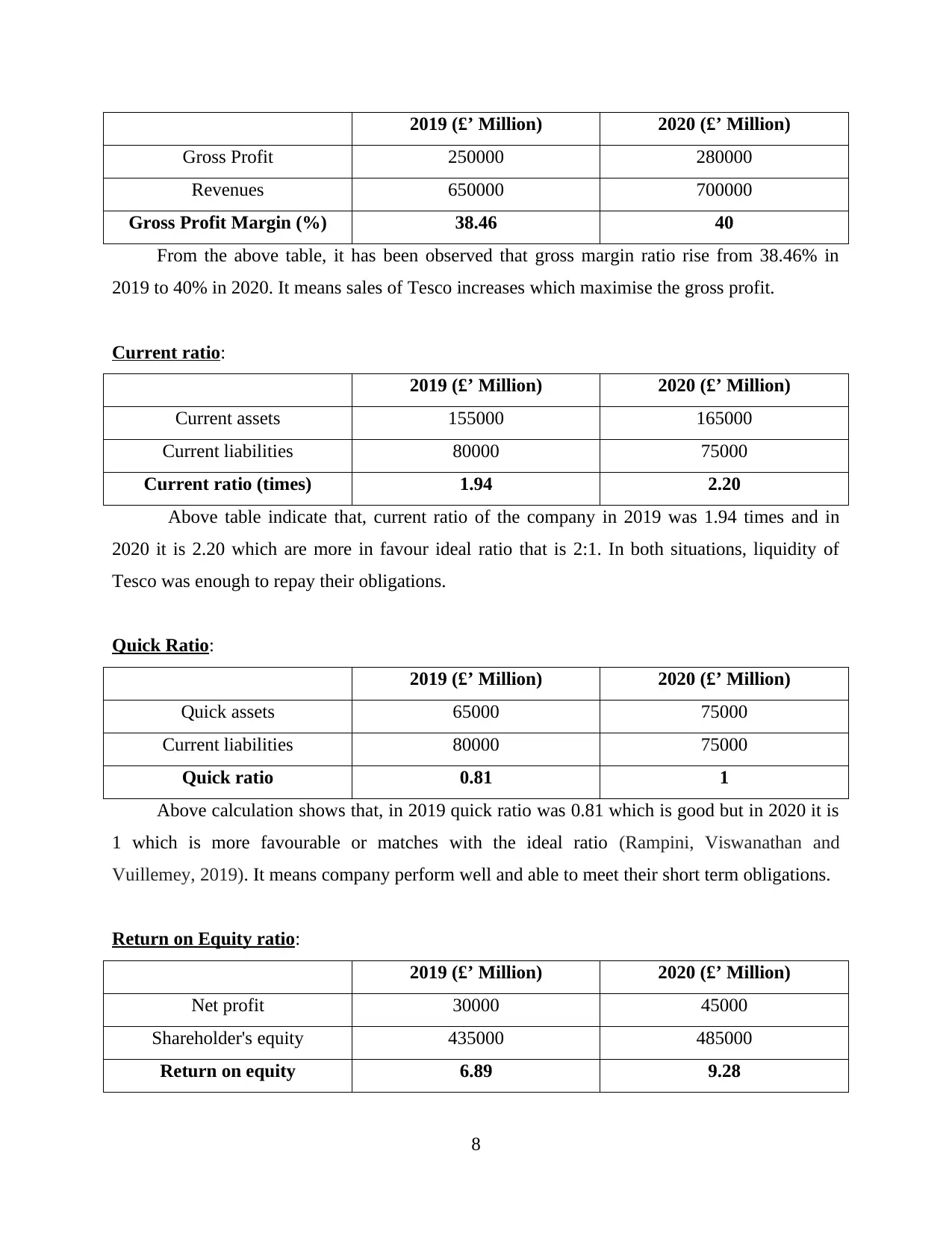
2019 (£’ Million) 2020 (£’ Million)
Gross Profit 250000 280000
Revenues 650000 700000
Gross Profit Margin (%) 38.46 40
From the above table, it has been observed that gross margin ratio rise from 38.46% in
2019 to 40% in 2020. It means sales of Tesco increases which maximise the gross profit.
Current ratio:
2019 (£’ Million) 2020 (£’ Million)
Current assets 155000 165000
Current liabilities 80000 75000
Current ratio (times) 1.94 2.20
Above table indicate that, current ratio of the company in 2019 was 1.94 times and in
2020 it is 2.20 which are more in favour ideal ratio that is 2:1. In both situations, liquidity of
Tesco was enough to repay their obligations.
Quick Ratio:
2019 (£’ Million) 2020 (£’ Million)
Quick assets 65000 75000
Current liabilities 80000 75000
Quick ratio 0.81 1
Above calculation shows that, in 2019 quick ratio was 0.81 which is good but in 2020 it is
1 which is more favourable or matches with the ideal ratio (Rampini, Viswanathan and
Vuillemey, 2019). It means company perform well and able to meet their short term obligations.
Return on Equity ratio:
2019 (£’ Million) 2020 (£’ Million)
Net profit 30000 45000
Shareholder's equity 435000 485000
Return on equity 6.89 9.28
8
Gross Profit 250000 280000
Revenues 650000 700000
Gross Profit Margin (%) 38.46 40
From the above table, it has been observed that gross margin ratio rise from 38.46% in
2019 to 40% in 2020. It means sales of Tesco increases which maximise the gross profit.
Current ratio:
2019 (£’ Million) 2020 (£’ Million)
Current assets 155000 165000
Current liabilities 80000 75000
Current ratio (times) 1.94 2.20
Above table indicate that, current ratio of the company in 2019 was 1.94 times and in
2020 it is 2.20 which are more in favour ideal ratio that is 2:1. In both situations, liquidity of
Tesco was enough to repay their obligations.
Quick Ratio:
2019 (£’ Million) 2020 (£’ Million)
Quick assets 65000 75000
Current liabilities 80000 75000
Quick ratio 0.81 1
Above calculation shows that, in 2019 quick ratio was 0.81 which is good but in 2020 it is
1 which is more favourable or matches with the ideal ratio (Rampini, Viswanathan and
Vuillemey, 2019). It means company perform well and able to meet their short term obligations.
Return on Equity ratio:
2019 (£’ Million) 2020 (£’ Million)
Net profit 30000 45000
Shareholder's equity 435000 485000
Return on equity 6.89 9.28
8
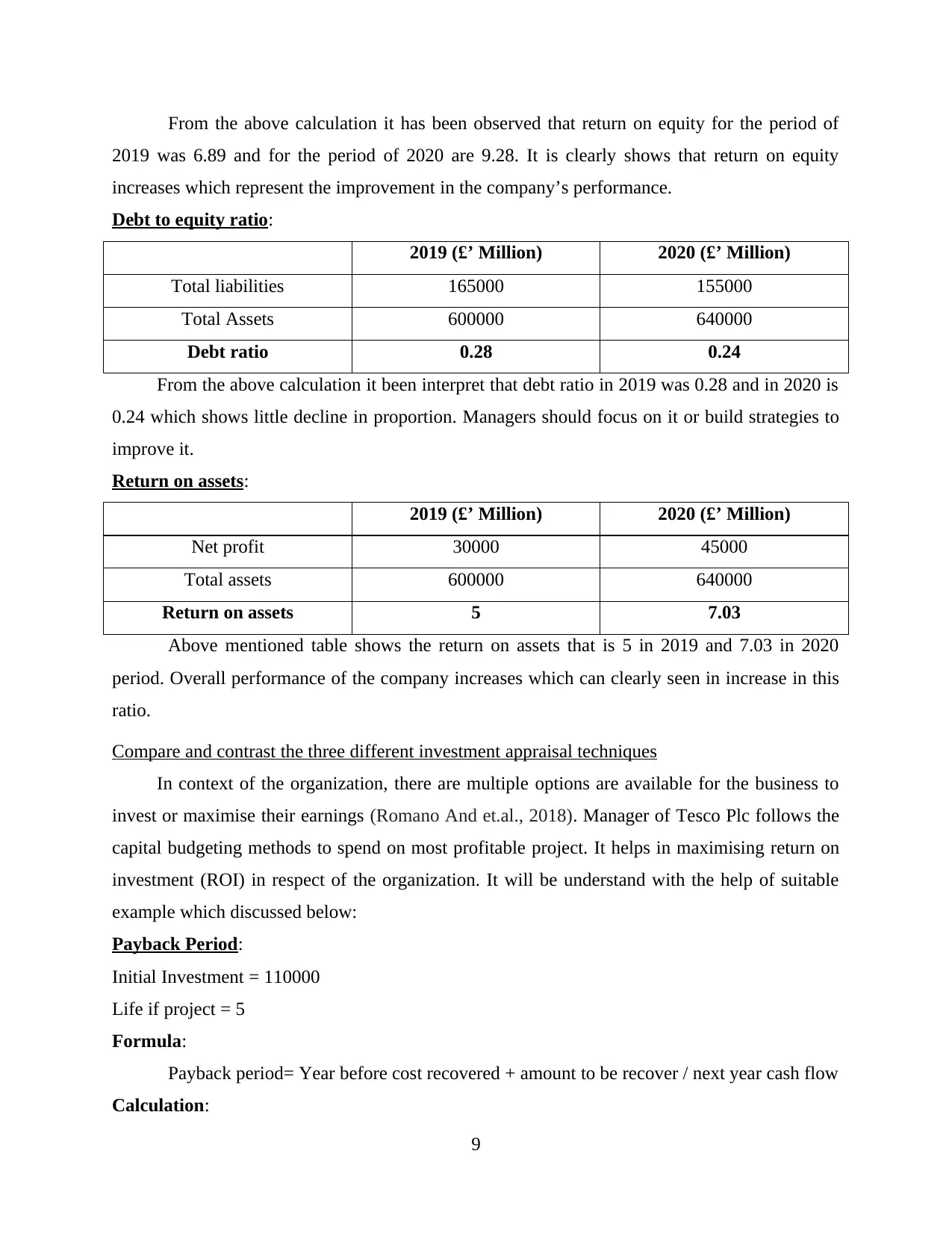
From the above calculation it has been observed that return on equity for the period of
2019 was 6.89 and for the period of 2020 are 9.28. It is clearly shows that return on equity
increases which represent the improvement in the company’s performance.
Debt to equity ratio:
2019 (£’ Million) 2020 (£’ Million)
Total liabilities 165000 155000
Total Assets 600000 640000
Debt ratio 0.28 0.24
From the above calculation it been interpret that debt ratio in 2019 was 0.28 and in 2020 is
0.24 which shows little decline in proportion. Managers should focus on it or build strategies to
improve it.
Return on assets:
2019 (£’ Million) 2020 (£’ Million)
Net profit 30000 45000
Total assets 600000 640000
Return on assets 5 7.03
Above mentioned table shows the return on assets that is 5 in 2019 and 7.03 in 2020
period. Overall performance of the company increases which can clearly seen in increase in this
ratio.
Compare and contrast the three different investment appraisal techniques
In context of the organization, there are multiple options are available for the business to
invest or maximise their earnings (Romano And et.al., 2018). Manager of Tesco Plc follows the
capital budgeting methods to spend on most profitable project. It helps in maximising return on
investment (ROI) in respect of the organization. It will be understand with the help of suitable
example which discussed below:
Payback Period:
Initial Investment = 110000
Life if project = 5
Formula:
Payback period= Year before cost recovered + amount to be recover / next year cash flow
Calculation:
9
2019 was 6.89 and for the period of 2020 are 9.28. It is clearly shows that return on equity
increases which represent the improvement in the company’s performance.
Debt to equity ratio:
2019 (£’ Million) 2020 (£’ Million)
Total liabilities 165000 155000
Total Assets 600000 640000
Debt ratio 0.28 0.24
From the above calculation it been interpret that debt ratio in 2019 was 0.28 and in 2020 is
0.24 which shows little decline in proportion. Managers should focus on it or build strategies to
improve it.
Return on assets:
2019 (£’ Million) 2020 (£’ Million)
Net profit 30000 45000
Total assets 600000 640000
Return on assets 5 7.03
Above mentioned table shows the return on assets that is 5 in 2019 and 7.03 in 2020
period. Overall performance of the company increases which can clearly seen in increase in this
ratio.
Compare and contrast the three different investment appraisal techniques
In context of the organization, there are multiple options are available for the business to
invest or maximise their earnings (Romano And et.al., 2018). Manager of Tesco Plc follows the
capital budgeting methods to spend on most profitable project. It helps in maximising return on
investment (ROI) in respect of the organization. It will be understand with the help of suitable
example which discussed below:
Payback Period:
Initial Investment = 110000
Life if project = 5
Formula:
Payback period= Year before cost recovered + amount to be recover / next year cash flow
Calculation:
9
⊘ This is a preview!⊘
Do you want full access?
Subscribe today to unlock all pages.

Trusted by 1+ million students worldwide
1 out of 18
Related Documents
Your All-in-One AI-Powered Toolkit for Academic Success.
+13062052269
info@desklib.com
Available 24*7 on WhatsApp / Email
![[object Object]](/_next/static/media/star-bottom.7253800d.svg)
Unlock your academic potential
Copyright © 2020–2025 A2Z Services. All Rights Reserved. Developed and managed by ZUCOL.





